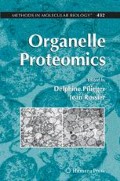Summary
Organelles are biochemically distinct subcellular compartments that perform specific functions within a cell. These roles are regulated by the complement of proteins associated with each organelle. Thus, a comprehensive understanding of an organelle’s proteome is necessary to elucidate the diverse roles of each organelle. Mass spectrometry combined with biochemical fractionation methods has enabled the proteomic characterization of several organelles. However, due to the poorly quantitative nature of mass spectrometry and the inability to generate pure fractions of an organelle, distinguishing bona fide components of the organelle from contaminants of the fraction is a significant challenge. We have addressed this limitation by adopting quantitative mass spectrometric approaches to identify proteins that enrich in a purified fraction of organelles relative to a crude or contaminating fraction. The methods for the analyses of the yeast peroxisome are described in detail; however, these concepts are generally applicable to the study of other organelles.
Access this chapter
Tax calculation will be finalised at checkout
Purchases are for personal use only
References
Aebersold, R. and Mann, M. (2003) Mass spectrometry-based proteomics. Nature 422, 198–207.
Brunet, S., Thibault, P., Gagnon, E., Kearney, P., Bergeron, J. J., and Desjardins, M. (2003) Organelle proteomics: looking at less to see more. Trends Cell Biol. 13, 629–638.
de Duve, C. (1992) Exploring cells with a centrifuge. In Nobel Lectures in Physiology 1971–1980 (Lindsten, J., ed.), World Scientific Publishing Co., London, pp. 152–172.
Marelli, M., Smith, J. J., Jung, S., Yi, E., Nesvizhskii, A. I., Christmas, R. H., et al. (2004) Quantitative mass spectrometry reveals a role for the GTPase Rho1p in actin organization on the peroxisome membrane. J. Cell Biol. 167, 1099–1112.
Smith, J. J., Marelli, M., Christmas, R. H., Vizeacoumar, F. J., Dilworth, D. J., Ideker, T., et al. (2002) Transcriptome profiling to identify genes involved in peroxisome assembly and function. J. Cell Biol. 158, 259–271.
Eng, J. K., McCormack, A. L., and Yates, J. R. III. (1994) An approach to correlate tandem mass spectral data of peptides with amino acid sequences in a protein database. J. Am. Soc. Mass Spectrom. 5, 976–989.
Han, D. K., Eng, J., Zhou, H., and Aebersold, R. (2001) Quantitative profiling of differentiation-induced microsomal proteins using isotope-coded affinity tags and mass spectrometry. Nat. Biotechnol. 19, 946–951.
Li, X. J., Zhang, H., Ranish, J. A., and Aebersold, R. (2003) Automated statistical analysis of protein abundance ratios from data generated by stable-isotope dilution and tandem mass spectrometry. Anal. Chem. 75, 6648–6657.
Keller, A., Nesvizhskii, A. I., Kolker, E., and Aebersold, R. (2002) Empirical statistical model to estimate the accuracy of peptide identifications made by MS/MS and database search. Anal. Chem. 74, 5383–5392.
Nesvizhskii, A. I., Keller, A., Kolker, E., and Aebersold, R. (2003) A statistical model for identifying proteins by tandem mass spectrometry. Anal. Chem. 75, 4646–4658.
Lee, R. T. (2000) Use of microarrays to identify targets in cardiovascular disease. Drug News Perspect. 13, 403–406.
Pan, W., Lin, J., and Le, C. T. (2002) How many replicates of arrays are required to detect gene expression changes in microarray experiments? A mixture model approach. Genome Biol. 3, 22.
Author information
Authors and Affiliations
Editor information
Editors and Affiliations
Rights and permissions
Copyright information
© 2008 Humana Press, a part of Springer Science+Business Media, LLC
About this protocol
Cite this protocol
Marelli, M., Nesvizhskii, A.I., Aitchison, J.D. (2008). Identifying Bona Fide Components of an Organelle by Isotope-Coded Labeling of Subcellular Fractions. In: Pflieger, D., Rossier, J. (eds) Organelle Proteomics. Methods in Molecular Biology™, vol 432. Humana Press. https://doi.org/10.1007/978-1-59745-028-7_24
Download citation
DOI: https://doi.org/10.1007/978-1-59745-028-7_24
Publisher Name: Humana Press
Print ISBN: 978-1-58829-779-2
Online ISBN: 978-1-59745-028-7
eBook Packages: Springer Protocols

